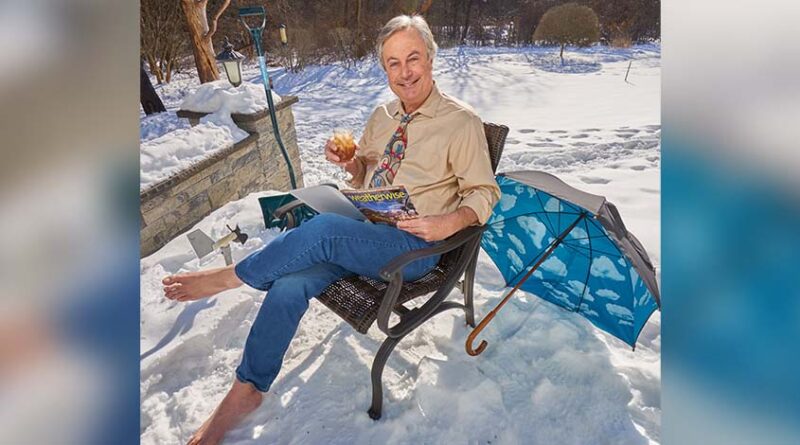The Weatherman
Kevin Williams has been as busy as ever, nearly five years after he left his job on local TV… and it’s still all about the weather: ‘It’s what I do. It’s in my bones. It’s in my DNA’
By John Addyman
ou can take the meteorologist out of the weather, but you can’t take the weather out of the meteorologist. That’s Kevin Williams.
“People know me from TV and for that I’m grateful,” he said. “But I have had the joy of a professional life that goes far beyond the screen and for that I consider myself immensely blessed.”
Williams, 62, of Penfield, is someone you know if you’ve lived inside the broadcast area of any Rochester television station because he’s been a weather guy at each one, starting with Channel 13 in 1982 and continuing through being the chief meteorologist at Channel 8 in 1989 to Channel 10 in 1996 and ending there in 2017.
His is also a voice you know if you’ve listened to radio weather forecasts in Dallas, Texas, Columbus, Ohio, Providence, Rhode Island, New York City, southeastern Pennsylvania, and provinces of Canada. In fact, Williams’ and his Weather-Track Inc. company today reach 90 radio markets every day.
If you’re in a courtroom in Alabama and the weather is an important consideration in a case, you shouldn’t be surprised if you find Williams sitting there as a forensic meteorologist expert witness.
Did you pick up a copy of the Democrat & Chronicle in the mid-1990s to read the weather forecast and the meteorology column? That was Kevin Williams’ byline.
And if you remember a story about a guy from Penfield who set up a snow-making machine in his backyard 20 years ago, something that made his two kids the most popular in the neighborhood, yep, he’s that guy.
Did you also know he’s helped create a weather exhibition at the Rochester Museum and Science Center? That he’s won a passel of TV newscast awards and hit the pinnacle with an Emmy and Edward R. Murrow Award for his coverage of the blizzard of 2017? That he was named Rochester’s most popular TV meteorologist several times?
Then it shouldn’t surprise you that the Washington Post declared him one of the nation’s coolest meteorologists in 2017.
Early start
His departure from the Rochester TV meteorologist musical chairs game occurred in 2017 when his contract wasn’t renewed by WHEC-TV Channel 10.
That meant he didn’t have three jobs to do anymore. He was down to two, both imbedded in his Weather-Track company, which he established in 1983, but really started while he was still in college.
In fact, Williams’ love of weather started much earlier than that.
“My mom tells me that when I was a toddler growing up on Long Island, there was a big thunderstorm one night and I was so enthralled by it she put me out in my playpen on the porch so she and I could watch it,” he said.
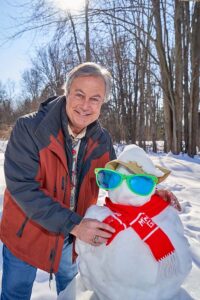
“Don’t try this at home. It’s not good to be out in a thunderstorm. I survived.
It started at that age, where I had a passion for weather.
“People in my profession, whom I looked up to, whom I aspired to be, whom I respected, have something in their genes, some defective DNA, so that when a storm comes everything else stops. They are captivated by it. People say, ‘There’s a storm coming,’ and many will say ‘Yuck!’ I am the one running toward the storm, that’s been my life, running toward the storm. I started very young and my parents nurtured that in every way possible. It’s what I do. It’s in my bones. It’s in my DNA.”
His mom, Pat, was a stockbroker, rising to vice president at Merrill Lynch.
His dad, Don, was a sportswriter for the Long Island Press and the Newark Star-Ledger.
“My mom and dad had contacts that allowed me to meet broadcasters in what would be my future profession,” he said.
Graduating from Commack South High School on Long Island, Williams was thrilled to be accepted at Penn State, until his mom took him for a visit to Cornell, where he fell in love with the campus, the program and the support he got there.
“My mom and I drove up to Cornell on a sleety April day,” he said. “We had lunch at the now-defunct Pancake House.”
A track hurdler and football place-kicker at Commack, Williams played a little defensive backfield for Cornell’s Big Red for one season.
“I rode the bench most of the time, but I did play for a year,” he said.
In the classroom, “the program was perfect for me: I had the opportunity to get my hands dirty right away. I didn’t have to wait through two years of theory and not touch anything. They let you get into it right away,” he said.
The entrepreneur strikes
Spend 60 seconds with Williams and you know he’s not a wallflower. In college, the world suddenly opened up for him.
“In spirit, I’m an entrepreneur,” he said. “I saw niches that could be filled.
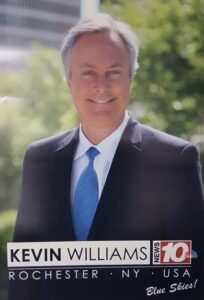
“First, on the radio side, I convinced a local radio station manager to put me on the air, at WTKO in Ithaca. As students we used do some reporting: occasionally we’d feed a newsbite or two. I made an impassioned plea to them about how we could produce viable, useful weather reports for their station. They agreed.
“I called a few other radio stations in New York and a business was born.
Cornell and the professors were very supportive. They let me use the facilities. I think I gave back a lot to Cornell. I created a partnership that exists today for students to anchor weather reports on the Ithaca College evening news.”
The beauty of that experience, and we’re talking 1980, is that Cornell’s meteorologists-to-be could get live experience in a studio and graduate with audio and video tapes, which were vital to getting a job.
For Williams, a big change in his life had already occurred.
“I ran the business, it was small, in my senior year. After graduation we moved into the DeWitt Building downtown. I had two partners, and at one point we had a 20-person staff. We did all kinds of things there.”
Within two years, his senior staff was itching for other opportunities and Williams had to make a bunch of decisions.
“We still had a great group of clients. So, we agreed I would just take the clients and they [my senior staff] would go their own ways.
“An opportunity arose at Channel 13 in Rochester to do TV, which is the one thing I could not do with the business, so I moved the business from Ithaca to Rochester in 1983. I commuted one year between Ithaca and Rochester. I worked evening TV Saturday and Sunday. On Sunday night, ABC always had a late-running movie, so our news wouldn’t go on until like midnight. By the time I had wrapped that up it was 1 a.m. I drove back to Ithaca on Route 96 in the middle of the winter trying to avoid the deer and I’d get back to Ithaca about 3 a.m. and I had to start my day at 4 a.m. because we had 75 individual stations and regional networks that had to be served.
“So, I didn’t sleep on Sunday nights for a year.”
Williams looks back on those days with no regret.
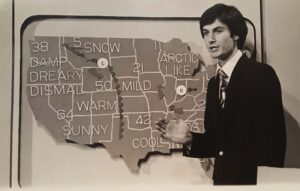
“I’m a big believer in paying dues. I worked one year on weekends, commuting, so I paid double my dues not sleeping on Sunday nights for a year. That’s how you do it. You learn from your mistakes in less-visible positions and from people above you who have been there before,” he said.
“I passed that down to people who followed me.”
The success of Weather-Track depended on learning two things, Williams said.
“One is quite obvious,” he said. “You need to be accurate. You need to know not only the weather but the surrounding areas and how the lakes and mountains come into play. The other thing you have to know, which believe it or not is very important but sounds kind of silly, is to know how all the towns are pronounced and know all the nuances.
“In Rochester, for example, if somebody came from out of the market and was going to do the weather, he might say, ‘If you live in Aay-von, Chilly or Leema, bring your coat.’ Right away people would say, ‘Who’s that guy?’
“So, I would always tell young people we’d hire, ‘Know the market. Know the people, the ball teams they root for.’
“Here’s a great example: We were on a station in Dallas and it was a new station for us, we had just started. There was a big tornado outbreak, we had coverage all the time, 24 hours, live on the air. After the event had passed and things had settled down, the station manager thanked me, and said the coverage was just what they were looking for. Then he added, ‘Tell your crew they did a great job. However, Kevin, we don’t have basements in Dallas.’
“When I said, ‘Go to your basement’ on our forecasts, people heard that and said, ‘Huh?’
“That’s the kind of lesson I learned, you have to know your market. Not just the science, but the politics and the sports and the pronunciation of the towns.”
The scientist in the studio
Williams, like any other meteorologist, is sensitive to the fact that he was the lone scientist on the TV broadcast team. He wasn’t reading something prepared by others, what he explained and what he demonstrated and taught people came from his training and experience and data.
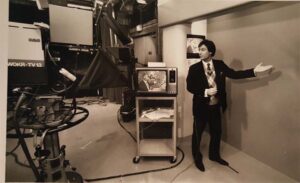
The radio experience was crucial because you needed to get a lot of information across in 30 seconds, but some station clients expected more repartee lasting three minutes. He was accustomed to getting the weather forecast across on radio with a stopwatch in his hand.
And when he was doing that from his first days in radio, ‘I didn’t know I was getting trained for TV,” he said.
“I see people who want to break into TV who have trouble being able to move, point fluidly, speak clearly and get time cues,” he said. “It’s a problem because they’ve never had to do it before. I trained as a kid to take on all of this.”
‘I am the one running toward the storm, that’s been my life, running toward the storm. I started very young and my parents nurtured that in every way possible. It’s what I do. It’s in my bones. It’s in my DNA.’
For Williams, words flow quickly and his delivery is always with a smile or genuine sincerity. He’s polite. He’s professional. He’s engaging. And his fans haven’t left him. His radio experience gives him the ability to clearly stress what he wants people to hear. His delivery comes fast or slow, the modulations fixing your attention. If he has an accent, it’s been scrubbed with care.
When he started out, forecasting was nowhere near as accurate as it is today.
By necessity, he made his own weather charts with colored pencils. Radar images came through on a fax machine and were fuzzy and cloudy.

“There were limitations,” he said. “In some ways it required more skill. I learned you could outshine your [TV meteorologist] competition if you worked harder and had that drive.”
Today, with instantaneous radar and high-resolution satellite images and all kinds of sophisticated computer models and programs, “you have to be even more accurate because you have more information,” he said.
What were once three-day forecasts now extend well beyond.
His business also includes industrial accounts, “businesses making mission-critical decisions based on what I tell them,” he explained.
That includes huge ships on the ocean as far away as Australia, landfill operations, maple sugar harvesters, balloonists. One of his clients is an aerial imaging company with clients in Hawai’i and Alaska.
Still on view
When his departure from Channel 10 came in 2017, he’d been there 21 years.
“I believe I am the longest-standing chief meteorologist in town, in this market, which is transient,” he admitted. Noting the movement of other well-known meteorologists who have followed paths similar to his from station to station, Williams said, “I think I started a trend.”
“But think about it: over the course of 37 years, I changed jobs twice. In this day and age is changing jobs twice in 37 years, is that unusual?” he said. “It seems that way. In TV, you’re invited into people’s home and you’re there.
Then suddenly you’re gone. That affects people. Sometimes they feel hurt.
“In local news there’s nothing more important than the weather, with all respect to my dear friends in news and sports. Nothing drives the ratings — nothing — like the appreciation of and the good spirit of and the fandom of the local meteorologist: it’s just the way it is. In every market, except maybe in some of the southern markets where the weather doesn’t change but almost everywhere else, the weather drives viewers.”
He has a case in point.
“When I left Channel 10 a lot of people were not happy and got in touch with me. So I said, ‘Let’s not make this the end. Let’s not stop here. Let’s get together Monday through Thursday at 5 p.m. and shoot the breeze on Faceboook (www.facebook.com/profile.php?id=100044245488842). I have sponsors for it. I do it as a labor of love. I had people follow me from station to station and I wasn’t ready to leave them in the lurch. I wanted to give them an option, and me an option, to have a platform. I don’t know where it’s going to take me, or where it’s going to go. The sponsors are happy,” he said.
And Williams has 18,000 followers for his chatty, neighborly show those four days a week. When you circle in to view it, you see the wall behind him covered with awards and articles and photos. You don’t see his collection of Star Trek phasers and memorabilia and autographs that are on the bookshelf to your left.
Thursday is his dress-down day, so viewers can’t experience viewing one of his 150-some weather-themed ties that fill a closet. But Monday through Wednesday, they’re on display. Some he bought, but many were given to him by viewers.
He also has a more immediate presence on Twitter (@wxbywilliams), useful for sharing things right now, which he does.
A court presence
A solid portion of his Weather-Track business is meteorological forensics.
Simply put, there are times when it’s important to understand weather conditions as part of a lawsuit. When you think about how much experience Williams has acquired in carefully looking at detailed weather data nationally for years on end, and his experience in forecasting and local knowledge, and his ability to get his points made in professional but understandable terms, he becomes an ideal expert witness.
When an insurance company needs some weather evidence, who you gonna call?
“They seek me out,” Williams said. “I don’t advertise. I’m sought out from as far away as New Hampshire and Alabama. Weather is important, and the lawyers want a scientist but they also want someone able to articulate things in a conversational way so the jury can say, ‘Oh, I get what he’s saying.’ It’s a fine line between science and a lay person understanding what you’re saying.
That’s what I’ve done and that’s how I built my reputation.
“If they seek me out to get the matter resolved, I’m just reporting my findings. I tell them objectively and they decide, based on the science, if that will help their strategy. I give it both sides all the time.”
Before the pandemic, Williams did a lot of traveling on forensic cases “just because I didn’t have enough to do in my life already,” he said. “A lot of those cases never go to trial, so I submit a report or affidavit and that’s sufficient. If I have to testify, that requires travel, which means scheduling with extreme precision and care to make sure everyone and everything in my business gets served.
“I work for attorneys and insurance agencies, I work for plaintiff and defense, whoever calls first.”
There’s an hourly fee for any report he writes, expenses for travel and fees for time in court.
Snowmaker
Kevin Williams’ wife, Beth, who is a mental health counselor, knew what she was getting into when they tied the knot in 1989. The honeymoon was in Paris and she allowed him a total of 15 minutes to watch one, just one, native French TV weather forecast.
Beth and Kevin raised Brandon and Brianna, two kids who got really popular on their street.
“I used to make snow here,” William said. “We did it for several years and it was a whole lot of fun. I’d drag out the snow-making machine and make a big hill of snow, 15 feet or so. When the kids were small, it became a winter resort for all the neighborhood children.
“At first the neighbors thought I was a Looney Tunes. ‘What?’ they’d say, ‘We don’t get enough snow?’
“But suddenly, when all their kids were over at our house spending the afternoon, they’d tell me, ‘That’s really a good idea you got there.’”
Then there was that one morning…
“When you make snow,” he said, “it’s not those big flakes — it’s kind of like a cloud, little crystals, very dense, easily pushed by the wind. After I came home from my late work, I’d go to the machine to make sure that it was moving in the right position so as to take advantage of any breeze. One night, the wind shifted unexpectedly and my neighbor woke early, heading off to work at Kodak. When she opened her garage door, there was a small pile of snow on her driveway and there was no snow in the forecast.
‘What the heck?’ she said, and she looked over and saw the snow blower running.”
Tapering
Owner of a successful business with a wide reach, Williams enjoys being present and accessible through his Facebook and Twitter accounts. Watch one of his programs during the week and you see a neighborhood guy entertaining good friends and dispensing, sharing helpful advice.
This is a good time for him.
“I love my work,” he said. “I get to talk on the radio. I get sought after by high-profile attorneys from insurance companies and others to be their expert. I have people making mission-critical decisions based on what I tell them; a boat out on the ocean, a company getting some aerial imagery and they need certain kinds of data. I don’t see that ending…I see it tapering. I’m not as young as I was.”
From those moments on the front porch in a thunderstorm to a year of sleepless Sunday nights traveled on Route 96 between Rochester and Ithaca, to a very satisfying life working out of his home but completely in tune with the weather all around him throughout the northern hemisphere, Kevin Williams knows he’s a lucky, centered man.
“I am never out of tune,” he said. “I am always in sync with the weather.” ■
Tracking the Weather
Weather-Track Inc., a company owned by Kevin Williams, has five employees. The company prepares weather broadcasts, many 30 seconds or so long for 90 radio stations. Some of those radio stations are in regional networks, owned by the same company, and one forecast can cover six or more radio stations.
Williams makes all those calls himself except on weekends, when one of his employees will pick up some of those calls. His employees are also busy doing forecasts and other work. His Facebook broadcasts at 5 p.m. Monday-Thursday are entertaining and provide a lot of specific, intimate detail on what’s going on for his followers.
In the Rochester area, Williams can be heard on the Family Life network found at 94.7 FM, WCJW-1140 AM and CJBQ-800 AM, among other stations.
Featured image: Kevin Williams in the backyard of his Penfield home on Jan. 31.

